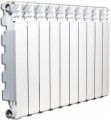The rated thermal output of the radiator is the amount of heat given off to the air in normal operation.
When choosing this parameter note that the heat output will depend on the temperature difference at the inlet and outlet to the radiator, as well as on the ambient temperature. The greater the temperature difference and the colder it is around, the more intense the heating will be. Therefore, in the specs, it is customary to indicate heat transfer for certain standard conditions. In particular, the designation according to the European standard EN-442 is very popular, which assumes heating medium temperatures of +75 °С and +65 °С at the inlet and outlet, respectively, as well as an air temperature of +20 °С. Real conditions and the actual heat output of the radiator may differ; therefore, when choosing, it is best to choose a model with a certain margin and compensate for excess power with one or another regulator. As for the actual values, in the most modest models, the heat output
does not exceed 750 W, or even
500 W, and in the largest, this figure can reach
3.5 – 4 kW or
more.
The choice for this parameter depends primarily on the size and specs of the heated space. The simplest calculation formula is as follows: at least 100 W of thermal power is required per 1 m2 of area. This formula is relevant for standard r
...esidential/office premises with ceilings of 2.5 – 3 m, without problems with thermal insulation; for more specific conditions, there are more detailed calculation methods, that can be found in special sources.
